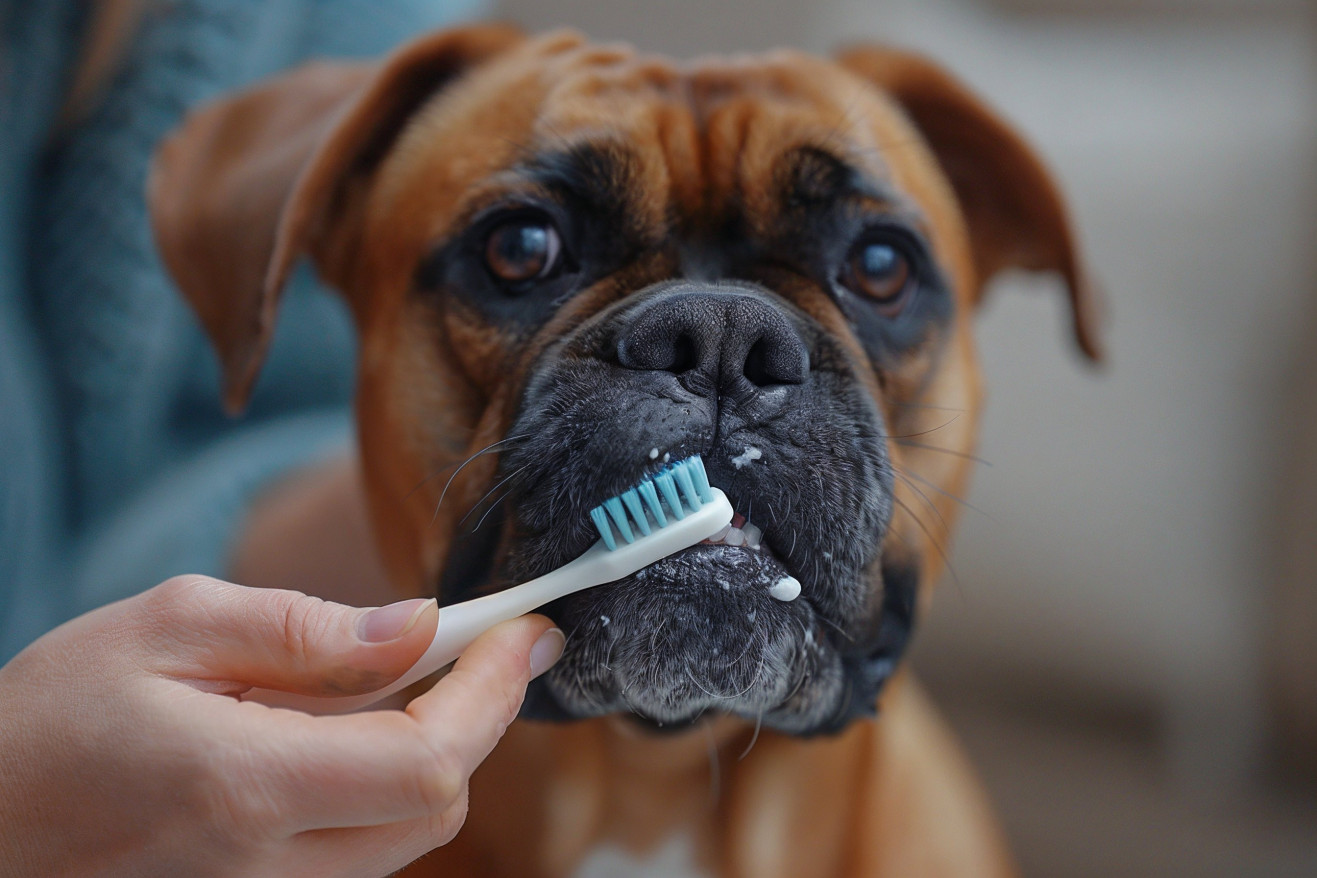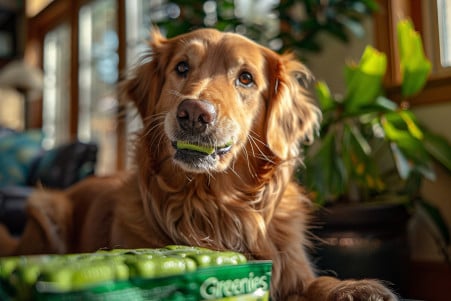Can Dogs Use Human Toothpaste? What Vets Recommend
29 March 2024 • Updated 29 March 2024

If you're thinking about sharing your toothpaste with your dog, you may want to think again. While it may be tempting to use human toothpaste on your dog, it's not the best option for keeping your dog's teeth clean and healthy. This is because human toothpaste contains ingredients that can be harmful to dogs, like fluoride and xylitol. As a result, it's important to use a toothpaste that's specifically designed for dogs and that's been formulated to meet their unique dental needs.
To help you understand the differences between human and dog toothpaste, we've looked at the latest veterinary studies and sought out expert advice. This article will help you learn which ingredients to stay away from, the best ways to keep your dog's teeth clean and healthy, and the best toothpaste alternatives to make sure your dog's smile stays bright and healthy without putting their health at risk. By learning more about what goes into a dog's dental care routine, you can make sure you're choosing the best toothpaste for your furry friend.
Can dogs use human toothpaste?
Dangerous Ingredients in Human Toothpaste for Dogs
If you use human toothpaste on your dog, you could be putting them at risk for a number of health problems due to the dangerous ingredients found in many human toothpaste formulas. For example, fluoride, which is commonly added to human toothpaste, can cause gastrointestinal issues such as vomiting and diarrhea in dogs when it’s ingested regularly, according to integrative veterinarian Dr. Julie Buzby, and in high amounts, it can even cause acute toxicity and lead to seizures.
Xylitol, an artificial sweetener that’s included in many human toothpaste products, is another dangerous ingredient. As explained by VCA Hospitals, xylitol can cause a rapid release of insulin in dogs, which can cause life-threatening hypoglycemia and potential liver failure if it’s ingested.
Sodium lauryl sulfate (SLS), which is used as a surfactant to create a foaming action, is another ingredient that can cause problems for your dog’s digestive system. According to Dr. Buzby, SLS can cause gastrointestinal upset in dogs if it’s swallowed during brushing. Meanwhile, triclosan and silica are two other ingredients that can be harmful to your pet if they’re ingested regularly.
To make sure your dog isn’t exposed to these dangerous ingredients, it’s important to only use toothpaste that’s specifically designed for dogs. By learning more about what your dog needs from their oral care routine, you can make sure you’re making the best choice to help them keep their teeth clean and healthy.
Signs of Common Dental Problems in Dogs
Periodontal disease, which is caused by bacterial plaque, is a common dental problem in dogs and can cause redness, swelling, and bleeding of the gums, and even tooth loss, according to Greensboro Vet. Meanwhile, plaque and tartar buildup can also cause bad breath, yellow or brown teeth, and difficulty eating, according to Lincoln Road Vet.
Other common dental problems in dogs are oral infections, tooth fractures, and developmental issues. Meanwhile, changes in the appearance of the mouth, loss of appetite, drooling, and a change in behavior are all signs that a dog may be experiencing dental problems, according to Morton Vet and Reedy Creek Vet.
It’s important to recognize these signs and symptoms early and seek treatment from a vet as soon as possible to address dental problems and prevent further issues that could affect a dog’s health and quality of life. With that in mind, let’s take a look at the best ways to brush a dog’s teeth at home.
How to Brush Your Dog's Teeth
To ensure that you're brushing your dog's teeth properly, you'll need to use the right tools and techniques. According to WebMD, veterinarians recommend using a soft-bristled dog toothbrush and dog toothpaste. Finger brushes are also a good option for dogs that weigh less than 30 pounds.
You'll also want to make sure you're introducing your dog to the process slowly, which means starting by getting them used to you handling their mouth and rewarding them with treats, according to the American Kennel Club. This will help them get used to the process and ensure that they're comfortable with it.
When you're actually brushing your dog's teeth, you'll want to gently lift their lip and focus on the outside of their teeth, using small, circular motions along the gum line, says VCA Animal Hospitals. You should aim to brush for at least 2 minutes and work up to brushing all of the surfaces of their teeth.
Consistency and positivity are key to ensuring that your dog's dental health stays in good shape. With the right tools and the right approach, you can make sure that this is a simple and effective part of your dog's routine. Next, we'll take a look at some other dental care products and alternatives you might want to try.
Dog Dental Care Products and Natural Alternatives
In addition to regular brushing, there are several dental care products and natural alternatives that can help keep a dog's teeth and gums healthy. As explained by PetMD, dental chews, treats, and water additives can be used in conjunction with a dog's dental care routine. However, it's important to make sure that these products have the Veterinary Oral Health Council (VOHC) seal of acceptance, which means that they have been tested and proven to be safe and effective.
Raw meaty bones and some fruits and vegetables can also help keep a dog's teeth clean through mechanical abrasion, according to the RSPCA. Meanwhile, Reedy Creek Vet suggests that dental-formulated dry dog food can help reduce plaque and tartar more effectively than wet or soft foods.
By using a combination of VOHC-approved products and natural alternatives, dog owners can help ensure that their pets' teeth and gums stay healthy and avoid more serious problems that may require professional treatment. This brings us to the importance of regular veterinary cleanings and the costs involved.
How Much Does Professional Dog Teeth Cleaning Cost and How Often Is It Needed?
Professional dog teeth cleaning can be expensive, with costs ranging from $250 to $900, according to PetMD. The cost can depend on the provider, the extent of the cleaning, and any additional services that are required, such as extractions, x-rays, or other dental work.
Veterinarians typically recommend annual cleanings for small dogs and cleanings every 1.5 to 2 years for larger dogs, according to Embrace Pet Insurance. The frequency of cleanings can also depend on a dog's age and the condition of their teeth.
While professional cleanings are essential to preventive dental care, the costs can be prohibitive. However, some pet insurance and wellness plans will pay for some of the costs, which can help make the expense more manageable, according to Forbes Advisor. Knowing how much professional dog teeth cleaning costs and how often it's needed can help dog owners plan and budget for this important part of their pet's care.
How to Keep Your Dog's Teeth Healthy
As noted by the VCA Animal Hospital, between 80 and 89% of dogs show signs of dental disease by the time they are 3 years old. Signs of dental pain in dogs can include a decreased appetite for dry food, drooling, and aversion to having their face or mouth touched.
The only way to relieve dental pain in dogs is to treat the dental disease that's causing it. This is done with a comprehensive oral health assessment and treatment (COHAT) that's performed under general anesthesia. The COHAT includes removing tartar from the teeth, examining the gums and teeth, and performing any necessary dental work, such as extractions or root canals. In some cases, veterinarians may also recommend oral medications, like antibiotics or pain relievers.
As the Animal Dental Center points out, it's important to know the signs of dental disease. Dog owners should regularly check their pet's teeth and gums by lifting their dog's lips and looking for signs of redness, discoloration, or bad breath, which can be signs of periodontal disease. Small dogs are especially prone to dental problems.
The best way to prevent dental pain and disease is through regular at-home dental care, like brushing your dog's teeth, and regular professional dental cleanings, which are usually recommended once a year for most dogs.
Wrapping Up: Veterinary Perspectives on Dogs and Human Toothpaste
Regular dental care, including brushing and professional cleanings, is essential for maintaining a dog's overall health and well-being. It's important to use dog toothpaste and avoid human toothpaste that can contain harmful ingredients. Early detection of dental problems and seeking veterinary care can help prevent more serious issues and expensive treatments.
By learning about the specific needs of a dog's dental care routine, pet parents can make the best choices to ensure their dogs have a healthy smile.


